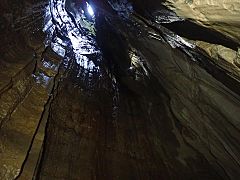Jingling Pot facts for kids
Quick facts for kids Jingling Pot |
|
|---|---|

Looking up the entrance shaft of Jingling Pot
|
|
| Location | West Kingsdale, North Yorkshire, UK |
| OS grid | SD 69896 78369 |
| Depth | 67 metres (220 ft) |
| Length | 61 metres (200 ft) |
| Discovery | 1867 |
| Geology | Carboniferous Limestone |
| Entrances | 1 |
| Hazards | Verticality |
| Access | Free |
| Cave survey | cavemaps.org |
Jingling Pot is a cool limestone cave located in West Kingsdale, North Yorkshire, England. It's right next to a stream called Jingling Beck. Imagine a deep, narrow hole, about 45 meters (148 feet) deep, that goes straight down from the ground!
At the bottom of this main shaft, the cave opens up into another room. Here, you can still see the initials of the first people who explored it, carved into the rock! From this room, a tight passage leads to smaller tunnels and cracks. These get very close to another cave system called Aquamole Pot. There are also other tunnels that go down next to the main shaft. You can get into these through a natural opening in the rock, just below the main entrance.
Contents
How Jingling Pot Formed
Jingling Pot is a type of cave called a karst cave. It formed in limestone rock that is about 335 million years old! This rock formed during a time called the Carboniferous Period.
The cave formed along a crack in the Earth's crust called a fault. Water from Jingling Beck helped create the cave. Nowadays, the stream usually flows around the cave entrance, except when there's a lot of rain. Scientists think the water originally flowed through Jingling Pot to the Aquamole Pot cave system, and then further down into the main underground water system of West Kingsdale.
Jingling Cave: A Nearby Discovery
Just a few meters north-west of Jingling Pot, the water from Jingling Beck disappears into another cave called Jingling Cave. This cave is about 375 meters (1,230 feet) long.
When you first enter Jingling Cave, it's quite low, so you have to crawl. But as you go further, the passage gets taller. You'll pass under a couple of spots where the cave roof has fallen in, creating natural "windows." After a damp 3-meter (10-foot) climb down, the passage leads into the much larger Rowten Caves system.
A Look Back: The History of Jingling Pot
People have known about Jingling Pot for a very long time! The first mention of it was by John Covel (1638-1722). He wrote about his travels and said he was "particularly pleased with Gingling Cove and Reeking Cove near Ingleton, which outdoe Oakey Hole in Somersetshire, and all the wonders of the Peak". This shows how impressive people found the cave, comparing it to other famous caves.
Later, in 1781, a poem by Thomas Dixon called A Description of the Environs of Ingleborough mentioned the cave:
"Near which are seen the clefts of GINGLING-COVE
The form and depth the curious ne'er could prove;
The falling stones from rock to rock rebound,
The dark abyss returns a tinkling sound."
This poem describes how stones dropped into the cave would make a "tinkling sound" as they bounced off the rocks, which is likely how the cave got its name "Jingling Pot."
In 1784, John Hutton gave a more detailed description. He said it was "a round aperture: narrow at the top, but most probably dilating in its dimensions to a profound depth. The stones we threw in made an hollow gingling noise for a considerable time."
In 1890, a person named Balderstone reported that he had measured the depth of Jingling Pot to be about 141 feet (43 meters). He also accurately described Jingling Cave, saying he had explored it for 225 yards (206 meters).
The very first time someone actually went down into Jingling Pot was in June 1897. This brave exploration was done by members of the Yorkshire Ramblers Club. Later, in 1969, members of the Grampian Speleological Society explored the other shafts that run parallel to the main entrance shaft.
Images for kids


